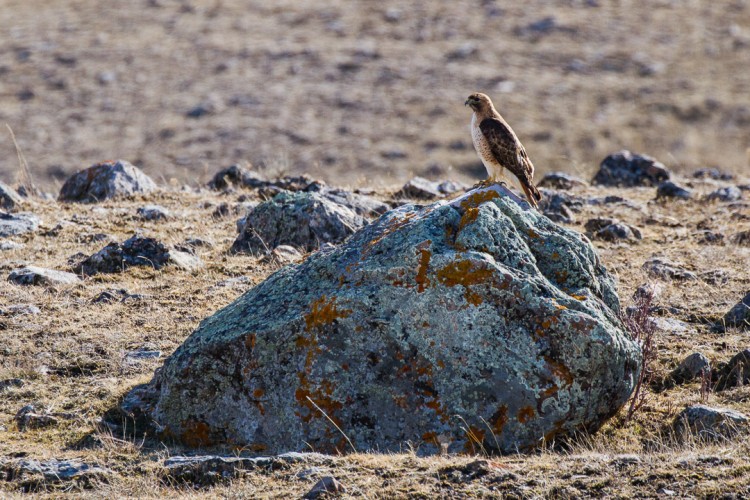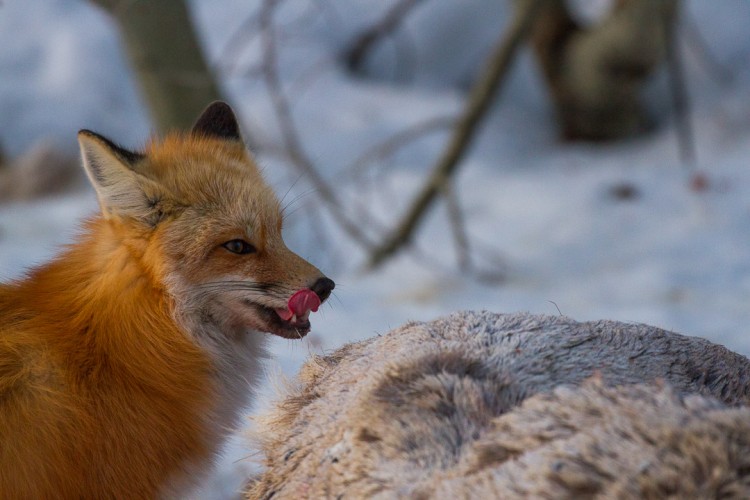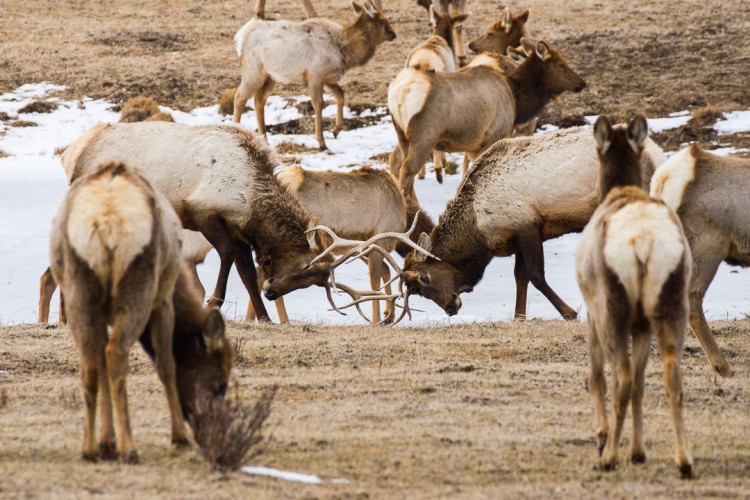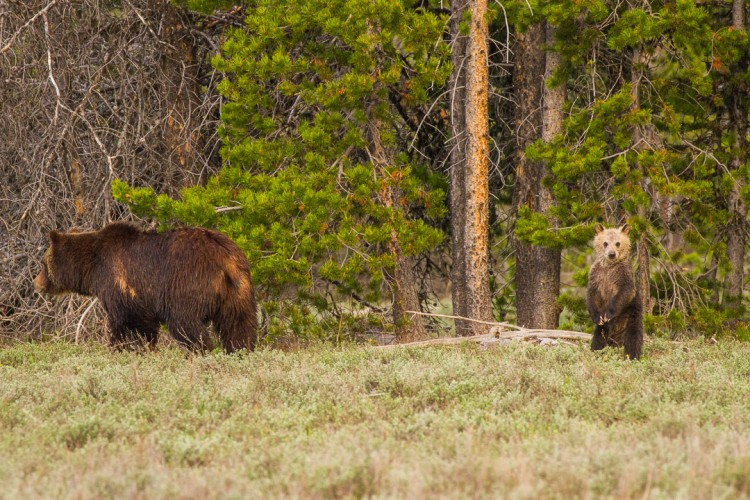Jackson Hole Wildlife Log Early March 2017


Early March has brought sounds and sights of spring to the Jackson Hole Valley. As we welcome the first day of spring (March 20th) mountain bluebirds, red winged blackbirds, american robins, and song sparrows, have returned, proclaiming their arrival in song. Snow in the valley is melting quickly though winter storms will likely return to the area. The first two weeks of March brought abundant wildlife sightings on Ecotours of Grand Teton National Park and the National elk Refuge, read the latest Jackson Hole Wildlife Log to learn more.
Returning Birds Great and Small
Warmer weather has led to insect hatches from our waterways, providing an early source of food for mountain bluebirds who deftly capture them from mid air. Arriving earlier than other cavity nesting birds our bluebirds get first choice in nest selection, though violet-green and tree swallows are not far behind and will compete for habitat such as nesting boxes along the National Elk Refuge. Male red-winged blackbirds have appeared in breeding plumage and are establishing territories in wetlands for the coming spring. We also recently observed a song sparrow doing the same.
Larger raptors are returning to Jackson Hole, with red-tailed hawk sightings on the National Elk Refuge, prairie falcons in Grand Teton National Park, and even a Northern Goshawk in the forest above the town of Jackson! These raptors have all spent the winter further south, avoiding Jackson Hole’s harsh climate. Sandhill cranes, standing over four feet tall, have been observed around the valley, some will nest on the refuge this summer, hopefully rearing babies known as colts!

Waterfowl are migrating into the valley including canada geese who will nest here. In a relatively recent development, some geese have chosen to occupy osprey nests atop platforms. When the osprey arrive they are unable to remove the new tenants and must seek other nest sites! Look for geese on these platforms as well as some nests that have been tilted by the Teton Raptor Center, saving them for osprey which will likely return to the valley later this month or in April.
Trumpeter swans are still concentrated in the Greater Yellowstone Ecosystem but will soon depart leaving just a few resident pairs in places like the National Elk Refuge and Yellowstone National Park.
We had a spectacular great gray owl sighting earlier last week. While observing one on a fence just outside of Grand Teton National Park it abruptly took flight, diving into the soft snow below. After a moment the owl lifted its head, swallowing a rodent, a successful hunt!

Using its large facial disks to concentrate sound, this great gray owl was able to locate and capture a small mammal in the snow below it, right before our eyes.
Pinnacle Peak and Lower Gros Ventre Wolf Packs!
The deep winter snows have concentrated many animals in the southern end of Jackson Hole, including several wolf packs. We found several wolves, likely from the Pinnacle Peak Pack, running across the National Elk Refuge and hunting on our recent wildlife tours.
A single black wolf pauses near a moving herd of elk on the National Elk Refuge, just minutes from Jackson’s Town Square. The Greater Yellowstone Ecosystem still has all of the large mammals, including carnivores, who existed here prior to the Lewis and Clark expedition
We have also been finding the Lower Gros Ventre pack in Grand Teton National Park. Judging by their long periods of sleep it is likely they made a kill and were contentedly resting in the sunshine, presumably with full stomachs. Wolves can eat upwards of 15 lbs in one sitting!
Coyotes have been tailing these packs from a distance. If they are careful, coyotes and other scavengers benefit from wolf kills, scavenging while the wolves sleep. However, wolves will kill coyotes who are not wary in a territorial response.

This fox was dining on a nearby elk carcass we think was killed by a mountain lion, given the nearby cat tracks in the snow. Research is showing that mountain lions are a critical part of the landscape, providing food for over 20 different species of animals ranging from grizzly bears to chickadees!
Foxes, coyotes, and wolves will all be seeking out den sites soon. Females became pregnant in late January or February, and will give birth around late April, just in time for a flush of life across the ecosystem.
Record Numbers of Elk on the Refuge and other big game sightings!
Snow in the southern end of Jackson Hole is melting quickly, allowing elk concentrated on the National Elk Refuge to spread out more to feed. Refuge staff counted 8,879 elk this winter, which is 78% above the objective of 5,000 elk. This concentration has lead to heavy contamination of elk feces on the refuge which has staff concerned about foot rot and other diseases which can prove fatal for elk. The refuge hopes to end supplemental feeding as soon as possible to encourage elk to migrate towards summer range. Some may travel as far as Yellowstone lake, some 60+ miles to the north!

We’ve been seeing a concentration of moose near the Gros Ventre intersection of Grand Teton National Park, including bulls who dropped antlers back in January. The pedicles, bony protrusions on the skull where antlers grow, are beginning to show signs of next years growth, the vast majority of antler development will not occur until after the green up of the landscape occurs in early summer. Moose are taking advantage of melting snows to feed on bitterbrush, a shrub which grows amongst the larger sagebrush plant out in the open flats of the Jackson Hole Valley.

During our wildlife tours in the National Elk Refuge we have been observing concentrations of bighorn sheep, mule deer, and a small group of pronghorn antelope in the southern end of the refuge. Adding these species to the already massive numbers of elk and 500 bison on the refuge, the refuge in winter resembles the African Serengeti. In just a few weeks the majority of these animals will begin epic migrations out of the valley.
The coming spring
As the last few weeks of skiing at Jackson Hole Mountain Resort come to an end, a dramatic transformation is already beginning. Soon our great herds of animals will migrate out of the valley into high elevation habitats now deeply covered with snow. Grizzlies have been documented in Yellowstone and will soon be found on our Grand Teton National Park Wildlife Safaris. Hundreds of bird species are now on the wing, heading towards the Greater Yellowstone Ecosystem, some traveling from as far as the Argentine Pampas in South America. Spring is well on its way.

With new migrants arriving to the valley almost daily, spring is one of the best times to take a wildlife tour in Jackson Hole. To learn more about a safari with Ecotour Adventures visit our website or call (307) 690-9533. We hope to see you soon!
Photos and blog by Naturalist Josh Metten













